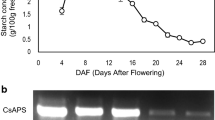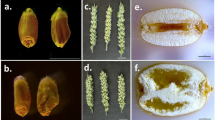Abstract
The biosynthesis of seed oil and starch both depend on the supply of carbon from the maternal plant. The biochemical interactions between these two pathways are not fully understood. In the Arabidopsis mutant shrunken seed 1 (sse1)/pex16, a reduced rate of fatty acid synthesis leads to starch accumulation. To further understand the metabolic impact of the decrease in oil synthesis, we compared soluble metabolites in sse1 and wild type (WT) seeds. Sugars, sugar phosphates, alcohols, pyruvate, and many other organic acids accumulated in sse1 seeds as a likely consequence of the reduced carbon demand for lipid synthesis. The enlarged pool size of hexose-P, the metabolites at the crossroad of sugar metabolism, glycolysis, and starch synthesis, was likely a direct cause of the increased flow into starch. Downstream of glycolysis, more carbon entered the TCA cycle as an alternative to the fatty acid pathway, causing the total amount of TCA cycle intermediates to rise while moving the steady state of the cycle away from fumarate. To convert the excess carbon metabolites into starch, we introduced the Escherichia coli starch synthetic enzyme ADP-glucose pyrophosphorylase (AGPase) into sse1 seeds. Expression of AGPase enhanced net starch biosynthesis in the mutant, resulting in starch levels that reached 37% of seed weight. However, further increases above this level were not achieved and most of the carbon intermediates remained high in comparison with the WT, indicating that additional mechanisms limit starch deposition in Arabidopsis seeds.




Similar content being viewed by others

References
Ballicora MA, Iglesias AA, Preiss J (2004) ADP-glucose pyrophosphorylase: a regulatory enzyme for plant starch synthesis. Photosynth Res 79:1–24
Cernac A, Benning C (2004) Wrinkled1 encodes an AP2/EREB domain protein involved in the control of storage compound biosynthesis in Arabidopsis. Plant J 40:575–585
Cross JM, Clancy M, Shaw JR, Greene TW, Schmidt RR, Okita TW, Hannah LC (2004) Both subunits of ADP-glucose pyrophosphorylase are regulatory. Plant Physiol 135:137–144
Dickinson DB, Preiss J (1969) ADP-glucose pyrophosphorylase from maize endosperm. Arch Biochem Biophys 130:119–128
Downing WE, Mauxion F, Fauvarque M-O, Reviron M-P, de Vienne D, Vartanian N, Giraudat J (1992) A Brassica napus transcript encoding a protein related to the Kunitz protease inhibitor family accumulates upon water stress in leaves, not seeds. Plant J 2:685–693
Emes MJ, Bowsher CG, Hedley C, Burrell MM, Scrase-Field ES, Tetlow IJ (2003) Starch synthesis and carbon partitioning in developing endosperm. J Exp Bot 54:569–575
Fiehn O, Kopka J, Trethewey RN, Willmitzer L (2000a) Identification of uncommon plant metabolites based on calculation of elemental compositions using gas chromatography and quadropole mass spectrometry. Anal Chem 72:3573–3580
Fiehn O, Kopka J, Dormann P, Altmann T, Trethewey RN, Willmitzer L (2000b) Metabolite profiling for plant functional genomics. Nat Biotechnol 18:1157–1161
Focks N, Benning C (1998) Wrinkled1: a novel, low-seed-oil mutant of Arabidopsis with a deficiency in the seed-specific regulation of carbohydrate metabolism. Plant Physiol 118:91–101
Geigenberger P, Kolbe A, Tiessen A (2005) Redox regulation of carbon storage and partitioning in response to light and sugars. J Exp Bot 56:1469–1479
Gibon Y, Vigeolas H, Tiessen A, Geigenberger P, Stitt M (2002) Sensitive and high throughput metabolite assays for inorganic pyrophosphate, ADPGlc, nucleotide phosphates, and glycolytic intermediates based on a novel enzymic cycling system. Plant J 30:221–235
Gibon Y, Blaesing OE, Hannemann J, Carillo P, Hohne M, Hendriks JH, Palacios N, Cross J, Selbig J, Stitt M (2004) A robot-based platform to measure multiple enzyme activities in Arabidopsis using a set of cycling assays: comparison of changes of enzyme activities and transcript levels during diurnal cycles and in prolonged darkness. Plant Cell 16:3304–3325
Ghosh HP, Preiss J (1966) Adenosine diphosphate glucose pyrophosphorylase. A regulatory enzyme in the biosynthesis of starch in spinach leaf chloroplasts. J Biol Chem 241:4491–4504
Ghosh HP, Meyer C, Remy E, Peterson D, Preiss J (1992) Cloning, expression, and nucleotide sequence of glgC gene from an allosteric mutant of Escherichia coli B. Arch Biochem Biophys 296: 122–128
Giroux MJ, Shaw J, Barry G, Cobb BG, Greene T, Okita T, Hannah LC (1996) A single mutation that increases maize seed weight. Proc Natl Acad Sci USA 93:5824–5829
James MG, Denyer K, Myers AM (2003) Starch synthesis in the cereal endosperm. Curr Opin Plant Biol 6:215–222
Kleczkowski LA, Villand P, Preiss J, Olsen OA (1993a) Kinetic mechanism and regulation of ADP-glucose pyrophosphorylase from barley (Hordeum vulgare) leaves. J Biol Chem 268:6228–6233
Kleczkowski LA, Villand P, Luthi E, Olsen OA, Preiss J (1993b) Insensitivity of barley endosperm ADP-glucose pyrophosphorylase to 3-phosphoglycerate and orthophosphate regulation. Plant Physiol 101:179–186
Kleczkowski LA (1999) A phosphoglycerate to inorganic phosphate ratio is the major factor in controlling starch levels in chloroplasts via ADP-glucose pyrophosphorylase regulation. FEBS Lett 448:153–156
Krebbers E, Seurinck J, Cashmore AR, Timko MP (1988) Four genes in two diverged subfamilies encode the ribulose-1,5-biphosphate carboxylase small subunit polypeptides of Arabidopsis thaliana. Plant Mol Biol 11:745–759
Lee YM, Kumar A, Preiss J (1987) Amino acid sequence of an Escherichia coli ADP-glucose synthetase allosteric mutant as deduced from the DNA sequence of the glgC gene. Nucleic Acids Res 15:10603
Lin Y, Sun L, Nguyen L, Rachubinski RA, Goodman HM (1999) The Pex16p homolog SSE1 and storage organelle formation in Arabidopsis seeds. Science 284:328–330
Lin Y, Cluette-Brown JE, Goodman HM (2004) The peroxisome deficient Arabidopsis mutant sse1 exhibits impaired fatty acid synthesis. Plant Physiol 135:814–827
Mansfield SG, Briarty LG (1992) Cotyledon cell development in Arabidopsis thaliana during reserve deposition. Can J Bot 70:151–164
Norton G, Harris JF (1975) Compositional changes in developing rape seed (Brassica napas L.). Planta 123:163–174
Parcy F, Valon C, Raynal M, Gaubier-Comella P, Delseny M, Giraudat J (1994) Regulation of gene expression programs during Arabidopsis seed development: Role of the ABI3 locus and of endogenous abscisic acid. Plant Cell 6:1567–1582
Plant AL, van Rooijen GJ, Anderson CP, Moloney MM (1994) Regulation of an Arabidopsis oleosin gene promoter in transgenic Brassica napus. Plant Mol Biol 25:193–205
Periappuram C, Steinhauer L, Barton DL, Taylor DC, Chatson B, Zou J (2000) The plastidic phosphoglucomutase from Arabidopsis. A reversible enzyme reaction with an important role in metabolic control. Plant Physiol 122:1193–1199
Preiss J, Shen L, Greenberg E, Genter N (1966) Biosynthesis of bacterial glycogen. IV. Activation and inhibition of the adenosine diphosphate glucose pyrophosphorylase of Escherichia coli B. Biochemistry 5:1833–1845
Preiss J (1984) Bacterial glycogen synthesis and its regulation. Annu Rev Microbiol 38:419–458
Roessner U, Wagner C, Kopka J, Trethewey RN, Willmitzer L (2000) Simultaneous analysis of metabolites in potato tuber by gas chromatography-mass spectrometry. Plant J 23:131–142
Salamone PR, Kavakli IH, Slattery CJ, Okita TW (2002) Directed molecular evolution of ADP-glucose pyrophosphorilase. Proc Natl Acad Sci USA 99:1070–1075
Sikka VK, Choi S, Kavakli IH, Sakulsingharoj C, Gupta S, Ito H, Okita TW (2001) Subcellular compartmentation and allosteric regulation of the rice endosperm ADP-glucose pyrophosphorylase. Plant Sci 161:461–468
Smidansky ED, Clancy M, Meyer FD, Lanning SP, Blake NK, Talbert LE, Giroux MJ (2002) Enhanced ADP-glucose pyrophosphorylase activity in wheat endosperm increases seed yield. Proc Natl Acad Sci USA 99:1724–1729
Smidansky ED, Martin JM, Hannah LC, Fischer AM, Giroux MJ (2003) Seed yield and plant biomass increases in rice are conferred by deregulation of endosperm ADP-glucose pyrophosphorylase. Planta 216:656–664
Sokolov LN, Dejardin A, Kleczkowski LA (1998) Sugars and light/dark exposure trigger differential regulation of ADP-glucose pyrophosphorylase genes in Arabidopsis thaliana (thale cress). Biochem J 336:681–687
Sowokinos J, Preiss J (1982) Pyrophosphorylases in Solanum tuberosum. III. Purification, physical, and catalytic properties of ADP-glucose pyrophosphorylase in potatoes. Plant Physiol 69:1459–1466
Stark DM, Timmerman KP, Barry GF, Preiss J, Kishore GM (1992) Regulation of the amount of starch in plant tissues by ADP-glucose pyrophosphoryalse. Science 258:287–292
Tetlow IJ, Morell MK, Emes MJ (2004) Recent developments in understanding the regulation of starch metabolism in higher plants. J Exp Bot 55:2131–2145
Vigeolas H, Mohlmann T, Martini N, Neuhaus HE, Geigenberger P (2004) Embryo-specific reduction of ADP-glc pyrophosphorylase leads to an inhibition of starch synthesis and a delay in oil accumulation in developing seeds of oilseed rape. Plant Physiol 136:2676–2686
Acknowledgments
We thank Dr. Nicki Engeseth for critical reading of the manuscript. This work was supported by start-up funds from the Department of Crop Sciences, University of Illinois to Y.L., The Illinois Agricultural Experimental Station, and a grant from The Department of Molecular Biology, Massachusetts General Hospital to H.M.G.
Author information
Authors and Affiliations
Corresponding author
Electronic supplementary material
Rights and permissions
About this article
Cite this article
Lin, Y., Ulanov, A.V., Lozovaya, V. et al. Genetic and transgenic perturbations of carbon reserve production in Arabidopsis seeds reveal metabolic interactions of biochemical pathways. Planta 225, 153–164 (2006). https://doi.org/10.1007/s00425-006-0337-6
Received:
Accepted:
Published:
Issue Date:
DOI: https://doi.org/10.1007/s00425-006-0337-6



